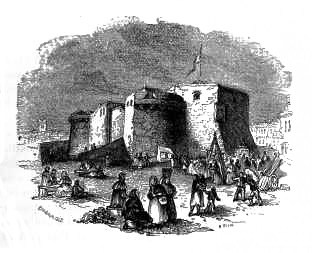Religious Orders in Ireland

Athlone Castle
The Age was not all Evil—Good Men in the World and in the Cloister—Religious Houses and their Founders—The Augustinians and Cistercians—Franciscans and Dominicans—Their close Friendship—Dominican Houses—St. Saviour's, Dublin—The Black Abbey, Kilkenny—Franciscan Houses—Youghal—Kilkenny—Multifarnham—Timoleague—Donegal—Carmelite Convents and Friars—Rising of the Connaught Men—A Plunderer of the English—Battle of Downpatrick—The MacCarthys defeat the Geraldines at Kenmare—War between De Burgo and FitzGerald.
[A.D. 1244—1271.]

EAL for founding religious houses was one of the characteristics of the age. Even the men who spent their lives in desolating the sanctuaries erected by others, and in butchering their fellow-creatures, appear to have had some thought of a future retribution—some idea that crime demanded atonement—with a lively faith in. a future state, where a stern account would be demanded. If we contented ourselves with merely following the sanguinary careers of kings and chieftains, we should have as little idea of the real condition of the country, as we should obtain of the present social state of England by an exclusive study of the police reports in the Times. Perhaps, there was not much more crime committed then than now. Certainly there were atonements made for offending against God and man, which we do not hear of at the present day.
Even a cursory glance through the driest annals, will show that it was not all evil—that there was something besides crime and misery. On almost every page we find some incident which tells us that faith was not extinct. In the Annals of the Four Masters, the obituaries of good men are invariably placed before the records of the evil deeds of warriors or princes. Perhaps writers may have thought that such names would be recorded in another Book with a similar precedence. The feats of arms, the raids, and destructions occupy the largest space. Such deeds come most prominently before the eyes of the world, and therefore we are inclined to suppose that they were the most important. But though the Annals may devote pages to the exploits of De Lacy or De Burgo, and only say of Ainmie O'Coffey, Abbot of the Church of Derry-Columcille, that he was "a noble ecclesiastic, distinguished for his piety, meekness, charity, wisdom, and every other virtue;" or of MacGilluire, Coarb of St. Patrick, and Primate of Ireland, that "he died at Rome, after a well-spent life,"[4]—how much is enfolded in the brief obituary! How many, of whom men never have heard in this world, were influenced, advised, and counselled by the meek and noble ecclesiastic!
The influence of good men is like the circle we make when we cast a little stone into a great stream, and which extends wider and wider until it reaches the opposite bank. It is a noiseless influence, but not the less effective. It is a hidden influence, but not the less efficacious. The Coarb of St. Patrick, in his "well-spent life," may have influenced for good as many hundreds, as the bad example of some profligate adventurer influenced for evil; but we are quite sure to hear a great deal about the exploits of the latter, and equally certain that the good deeds of the former will not be so carefully chronicled.
Nor should we at all suppose that piety in this age was confined to ecclesiastics. The Earls of Pembroke stand conspicuously amongst their fellows as men of probity, and were none the less brave because they were sincerely religious. At times, even in the midst of the fiercest raids, men found time to pray, and to do deeds of mercy. On one Friday, in the year of grace 1235, the English knights, in the very midst of their success at Umallia, and after fearful devastations commanded "that no people shall be slain on that day, in honour of the crucifixion of Christ."[5] It is true they "plundered and devastated both by sea and land the very next day;" but even one such public act of faith was something that we might wish to see in our own times. After the same raid, too, we find the "English of Ireland" and the Lord Justice sparing and protecting Clarus, the Archdeacon of Elphin, and the Canons of Trinity Island, in honour of the Blessed Trinity—another act of faith; and the "Lord Justice himself and the chiefs of the English went to see that place, and to kneel and pray there." On another occasion the "English chiefs were highly disgusted" when their soldiers broke into the sacristy of Boyle Abbey, and "took away the chalices, vestments, and other valuable things." Their leaders " sent back everything they could find, and paid for what they could not find."[6] We must, however, acknowledge regretfully that this species of "disgust" and reparation were equally rare. To plunder monasteries which they had not erected themselves, seems to have been as ordinary an occupation as to found new ones with a portion of their unjust spoils.
Notes
[4] Life.—Annals, vol. iii. p. 189.
[5] Christ—Annals, vol. iii. p. 281.
[6] Find.—Ib. vol. iii. p. 275.
